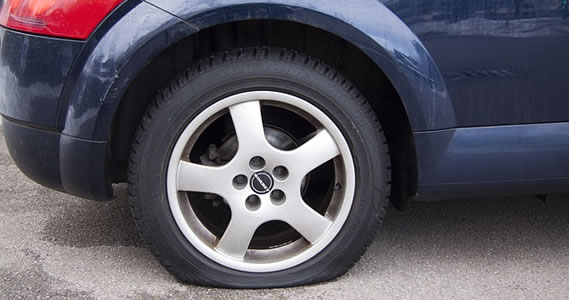A flat tire is one of the most common problems on the road. New drivers should be prepared to deal with the following situations involving a loss of air pressure in the tires. Don’t leave a new driver without these instructions to help them if the worst should happen.
Measuring Tire Pressure
Modern cars are equipped with tire pressure monitoring systems. Such digital technology automatically alerts when the gauge pressure in any tire drops below normal. A flat tire signal light may come on in the dashboard or central console. However, such a warning doesn’t always imply that there is a flat tire. Drivers should be able to use manual gauges to measure the gauge pressure of each tire. As long as the tire gauge pressure is above 25 psi, it’s still safe to drive.
Inflation
A driver may be able to inflate a tire that has lost a few PSI in gauge pressure. Simple battery powered air pumps can be used to inflate a car tire back to normal condition. Such pumps can also be connected directly to the battery pack under the hood. A tire may not always go flat right away. For example, a screw or nail may gradually reduce the internal pressure of a tire. It might take several hours for a tire to completely lose all of its air through small punctures. Keep a sharp eye on all your tires throughout the week.
Quick Patchwork
A deflated tire could be fixed without any roadside assistance. A relatively small screw or nail can be removed from the tire tread with pliers. A hole that’s not too deep may be patched with tire sealant that’s available in aerosol cans. After the patching, the entire tire can be inflated to the proper gauge pressure. When inflating a completely deflated tire, it’s important to use a jack to balance the vehicle when above the ground.
Roadside Assistance
Changing a tire might be out of the comfort level of new drivers. Roadside assistance can quickly remove a deflated tire and install a spare tire. However, a spare tire could only last for a few dozen miles. During a flat tire problem, a towing service may be needed to bring a car back home. Drivers should be equipped with the right phone numbers to call and the specific instructions for what to do in each situation.
Drivers can take different steps to handle a flat tire without any assistance. It is always a good idea to prepare new drivers with the basics on how to care for a car and it’s tires. With the right instructions, any new driver can get ready for any kind of emergency situation.
Article Credit: supplied by Milwaukee OWI law firm














